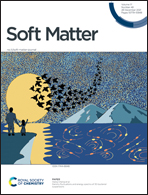Mechanical strength enhancement by grain size reduction in a soft colloidal polycrystal†
Abstract
It has long been known that the mechanical strength of finely grained solid state polycrystals could be enhanced when the grain size is reduced. Indeed, the equation linking the yield stress and the inverse square root of grain size was introduced in the 1950s by Hall and Petch. Since then this relationship has been widely used to engineer structural metals and alloys. To date, no similar behavior has been reported in materials other than atomic systems where the grain size usually lies in the nanometric range. The purpose of the present work is to study the influence of grain size on the mechanical strength enhancement of a soft colloidal ‘alloy’ made of micellar polycrystalline grains and silica nanoparticles. The nanoparticles act as nucleation sites and their concentration promotes the variation of the polycrystalline grain size. This system bears resemblance to solid state polycrystals; however the achieved grain length scale is situated in the micrometric domain. We show that the grain size evolves non-monotonically, first decreasing then increasing, when the nanoparticle concentration increases. Our main result is that the yield stress rigorously obeys the Hall–Petch law and follows a linear variation as a function of the inverse square root of the grain diameter. We believe that our experimental approach offers new possibilities to study the poorly understood mechanical aspects of polycrystalline and nanocrystalline structures, such as their plasticity, using non-destructive techniques.



 Please wait while we load your content...
Please wait while we load your content...